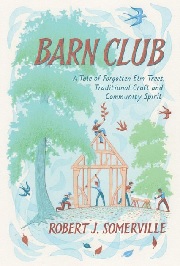Barn Club: A Tale of Forgotten Elm Trees, Traditional Craft and Community Spirit

Robert J. Somerville
Chelsea Green Publishing, £20.00
The Carley Barn, in Hertfordshire, was built from elm by hand in just one year using ancient skills. Barn Club describes how a group of around fifty craft people and willing apprentices, all volunteers, worked together to build this barn. Much is made of the practical skills used, particularly woodworking, but also the benefits of working together as a community. Similar efforts such as ‘Rendezvous’ projects, where carpenters gather to work on projects and international Charpentieres sans Frontières (Carpenters without borders) are mentioned. The chapter titles provide a flavour of the book, for example: A Different Way of Working; Boxed Hearts and Waney Edges and Two Buckets Full of Pegs.
Not all ideas may sit comfortably with all biologists, such as elm being a tree with an enduring life force and that our 'cells are completely at home' when we walk through a wood. Putting these aside as dramatic licences, there is much good biology included, particularly in the Wych Elms, Field Elms and Wildings chapter, where the natural history and historic importance of elms are described.
Memorable ‘nuggets’ include the comparison of emerging elm leaves with the shape of red squirrels’ tufted ears, as a basis for the old saying that beans should be planted when elm leaves are the size of squirrels’ ears. It is encouraging to read that the author estimates that about one thousand elms remain in the UK with trunks over three feet in diameter though how these have survived the elm disease remains a mystery.
Overall, the book tells a unique story with drawings and photos to complement it. Barn Club is likely to appeal to arboriculturists, foresters, plant pathologists, green architects and creative woodworkers. It would be essential reading for anyone thinking about trying a similar project.
Dr Sue Howarth CBiol FRSB


